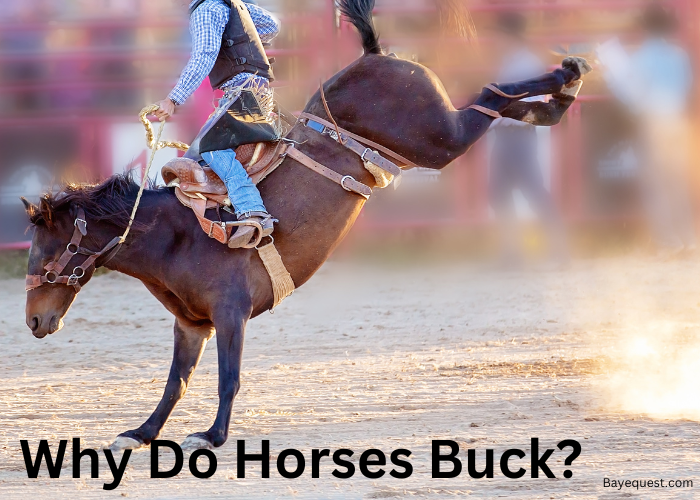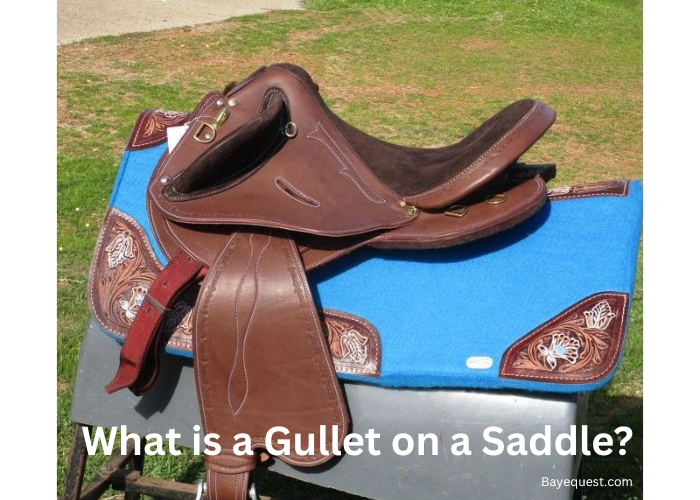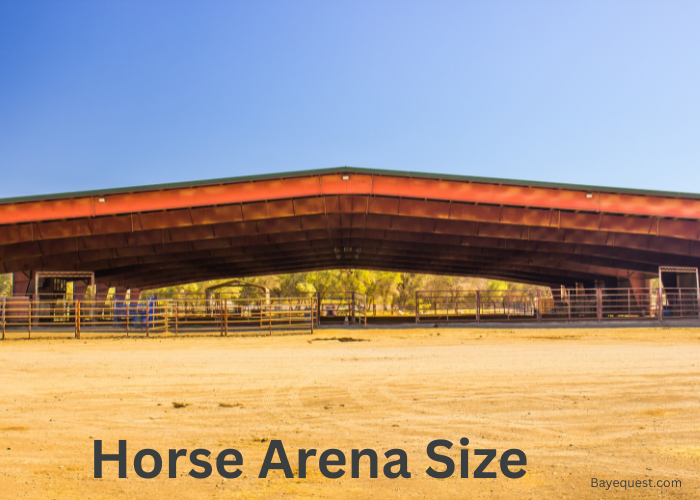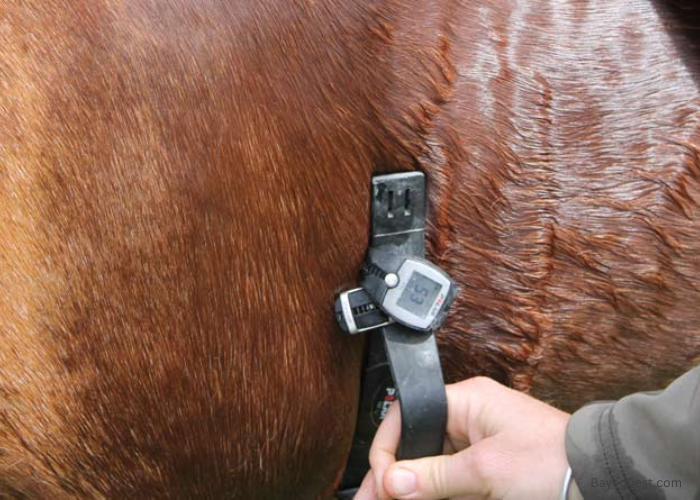Horses are majestic, powerful, and sometimes unpredictable.
One moment, you’re enjoying a smooth ride. The next, your horse bucks, leaving you puzzled or even on the ground.
Why does this happen? Is it anger, fear, or just play? Bucking can mean many things, and it’s your horse’s way of communicating.
Understanding this behavior is key to building trust and keeping both of you safe. In this post, we’ll dive into why horses buck and what you can do about it.
Let’s untangle the mystery together.
Why Do Horses Buck? Key Takeaway
Horses buck for various reasons, like discomfort, fear, or excitement, an ill-fitting tack, pain, or anxiety. Bucking can also happen due to playful energy or unfamiliar situations. Understanding why your horse bucks helps prevent accidents and improve training for a safer, and more comfortable ride.
What is Bucking in Horses?
Bucking is a sudden, forceful movement where a horse arches its back, lowers its head, and kicks out its hind legs into the air.
It can happen during riding, groundwork, or even when a horse is free in a field.
Horses buck for many reasons—sometimes out of playfulness, excitement, or frustration.
It can also be a way to express discomfort or resistance to something bothering them.
While it’s a natural behavior for horses, bucking can be dangerous, especially when you’re in the saddle.
Understanding why it happens is the first step to addressing it.
12 Common Reasons Why Horses Buck
Understanding why your horse bucks is the first step to solving the problem.
In this section, we’ll explore 12 common reasons why horses buck, helping you identify what’s behind this behavior and how to respond effectively.
Let’s get to the root of the issue.
1. Uncomfortable tack
Ill-fitting tack is a common cause of bucking. A tight saddle can press into the horse’s back.
A loose saddle may shift and rub. Bridles that pinch or sit unevenly can irritate sensitive areas.
Even small adjustments can create big discomfort. Over time, this pain builds and frustrates the horse.
Bucking is the horse’s way of escaping the irritation. Pressure points, pinching, or chafing often go unnoticed.
Horses rely on well-fitting tack for comfort. If something feels wrong, they react.
Their reaction is not random—it’s a plea to stop the discomfort.
2. Unbalanced rider
Riders who lack balance can unknowingly cause harm.
When a rider leans too far forward, the horse’s shoulders feel strain. Leaning too far back shifts weight to the hindquarters.
Even subtle shifts can throw off the horse’s natural movement. It tries to compensate, which is exhausting.
Over time, the horse may buck to restore balance or relieve tension. It’s not defiance—it’s a reaction to physical strain.
Horses are sensitive to every move a rider makes. An unsteady rider creates an unsteady horse, and bucking becomes its way to express discomfort.
3. Kissing spines
Kissing spines is a painful condition in horses. It happens when the vertebrae in the back touch or overlap.
This causes sharp, constant pain when the horse moves. Pressure from a rider makes it worse.
The pain feels like stabbing or pinching with every step. Bucking is often the horse’s desperate response to this agony.
This condition limits flexibility and makes even standing uncomfortable. Horses with kissing spines struggle to carry weight.
They buck not out of anger but because they hurt. This is their way of saying, “I can’t take this anymore.”
4. Dental pain
Horses with dental pain often react during riding. Sharp teeth edges can cut into the cheeks.
A decayed tooth may throb under pressure. Bits can push against these painful areas, making things worse.
Horses may shake their heads or try to avoid the bit. If the pain becomes unbearable, they buck.
This is their way of escaping what hurts them. Dental issues can go unnoticed for months.
Pain in the mouth affects their ability to eat, chew, or accept commands. When riding worsens that pain, bucking is their natural response.
5. Limb injury
Injured limbs make moving painful. A swollen joint can throb with every step.
Torn ligaments or muscle strains limit motion. When weight shifts to an injured leg, it hurts.
To relieve pressure, a horse may buck. It’s their way of redistributing weight.
Even minor bruises can cause irritation. Injuries often aren’t visible but show in behavior.
Bucking is a red flag that something hurts. Horses rely on all four legs for balance.
When one is compromised, they act out. Bucking helps them communicate that something is wrong.
6. Back pain
Back pain is a common issue in horses. It can come from muscle strain, overwork, or poor posture.
Heavy riders or repeated jumping make it worse. A sore back makes even walking uncomfortable.
Pressure from a saddle intensifies the pain. Horses often buck to relieve this discomfort.
It’s their way of telling you, “This hurts.” Back pain can also lead to stiffness or reluctance to move.
A horse may resist commands or act irritable. Bucking is one of the clearest signs that something isn’t right.
7. Sacroiliac joint pain
The sacroiliac joint connects the spine to the pelvis. Pain here limits a horse’s movement.
It can cause stiffness in the hindquarters or trouble with transitions. Jumping, turning, or carrying weight becomes a struggle.
This area endures stress from uneven footing or hard landings. Horses with sacroiliac pain often buck when pressure increases.
The pain is deep and hard to detect without exams. Affected horses may also swish their tails or drag their feet.
Bucking signals their frustration and physical strain.
8. Gastric ulcers
Gastric ulcers cause burning pain in the stomach lining. Horses develop them from stress, long periods without food, or high-grain diets.
The pain worsens during exercise or when the stomach empties. Bucking can occur as a reaction to this internal discomfort.
A horse with ulcers may also lose weight or appear irritable. It may refuse to work or resist being saddled.
The pain can feel sharp and constant, prompting sudden bursts of reaction. Bucking is often how they show that something is wrong inside.
9. Diet
An improper diet can cause energy spikes or deficiencies. Excess sugar or starch leads to hyperactivity.
Horses may feel jittery, tense, or restless. A lack of nutrients weakens muscles, making movement harder.
Both conditions can trigger bucking. Sudden changes in feed can also upset the horse’s system.
This creates discomfort or unease, which they express physically. Overfeeding can result in extra energy that the horse struggles to control.
A balanced diet is crucial to prevent unpredictable reactions like bucking.
10. Joy
Sometimes, bucking is simply a display of joy. Horses feel playful, especially in cooler weather or after a rest day.
They might buck out of excitement during a gallop. This behavior is often lighthearted and less aggressive.
It’s a way of releasing pent-up energy. You might notice it when they first go into a field or start a ride.
While joyful bucking is less concerning, it can still catch a rider off guard. It shows the horse is feeling spirited and alive.
11. Competition atmosphere
The energy at competitions can overwhelm some horses. Crowds, noise, and unfamiliar environments add stress.
Horses may feel tense or overstimulated. Adrenaline surges can heighten their sensitivity.
Bucking may occur as a reaction to this sensory overload. A horse under stress often looks alert and fidgety.
They might misinterpret commands or resist performing. The heightened energy around them amplifies their reactions.
Bucking becomes a way of coping with the pressure and excitement of the competition setting.
12. Fear
Fear triggers a horse’s flight-or-fight response. Sudden noises, unfamiliar objects, or predators cause panic.
Bucking is a defensive reaction to perceived danger. It’s a way to dislodge what they fear or prepare to flee.
Horses are naturally wary animals and overreact to threats. Even minor stimuli, like rustling leaves or a barking dog, can startle them.
Fear-driven bucking is often accompanied by wide eyes and tense muscles. It shows the horse is trying to protect itself from a situation it doesn’t understand.
What to Do if Your Horse Bucks
If your horse bucks, stay calm and focused. Reacting harshly can escalate the situation.
First, check your balance and hold onto the reins securely to avoid falling. Try to sit deep in the saddle and keep your heels down to stabilize yourself.
Don’t pull hard on the reins—it can worsen the bucking. Instead, gently guide your horse forward, as moving can disrupt their ability to buck.
After regaining control, assess the situation. Look for possible triggers, such as ill-fitting tack, injuries, or environmental stressors.
Observing your horse’s behavior can provide clues to the cause. Addressing the root issue is crucial to preventing further incidents.
If bucking becomes a pattern, consult a trainer or veterinarian for professional advice.
Remember, patience and understanding are key to resolving this behavior.
How to Stop Horses from Bucking
Stopping a horse from bucking requires a mix of training, patience, and understanding.
Start by identifying the cause—whether it’s discomfort, fear, or poor riding habits.
If it’s related to tack, ensure everything fits properly, including the saddle, bridle, and girth.
If you suspect physical issues like back pain or injuries, consult a veterinarian.
Training is essential. Begin with groundwork to build trust and teach your horse to respond to gentle cues.
Use consistent, calm commands to prevent reactive bucking. Focus on strengthening your horse’s muscles and improving their balance through proper exercises.
Gradually desensitize your horse to new experiences and environments, especially if bucking is due to fear or excitement.
If the behavior continues, working with a professional trainer who understands equine behavior can help correct the issue.
See also: Horse Flehmen Response.
Why Does My Horse Buck? Conclusion
Bucking is a horse’s way of communicating. It can be caused by discomfort, fear, or excitement.
Understanding why your horse bucks is the first step in solving the problem. Whether it’s physical pain or a behavioral reaction, addressing the cause is key.
With patience, proper training, and care, you can help your horse feel better and work more comfortably.
Remember, horses don’t buck for no reason—they’re telling you something. Listen closely, and you’ll both find a way to ride smoothly together.








